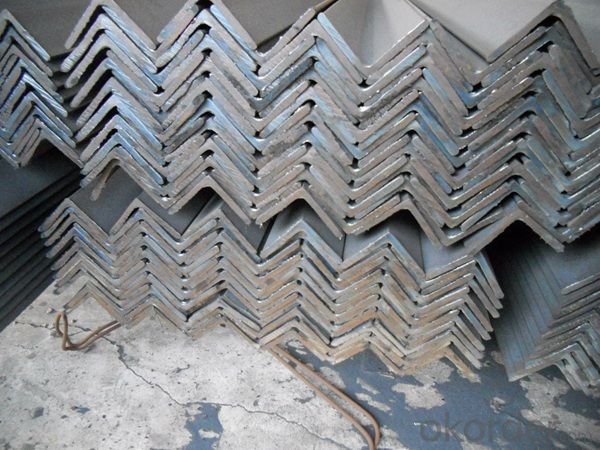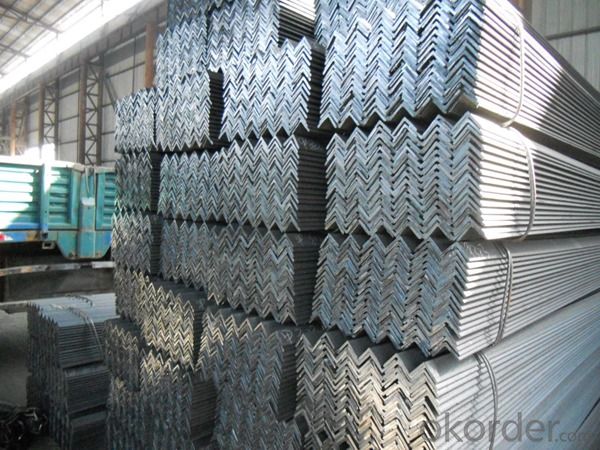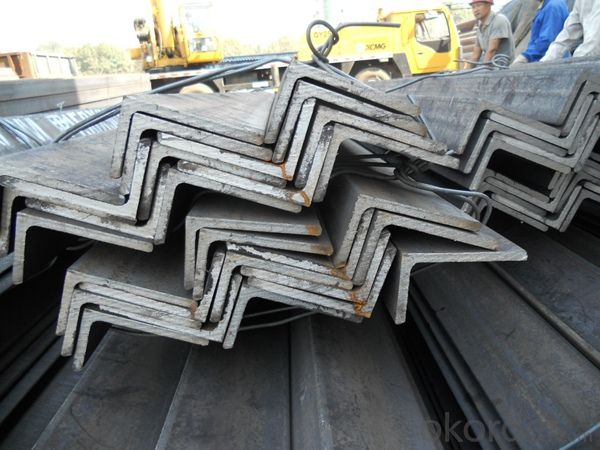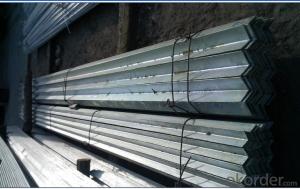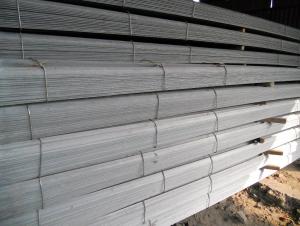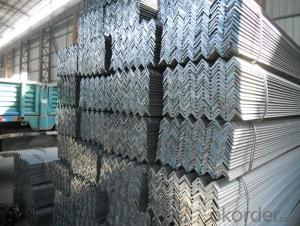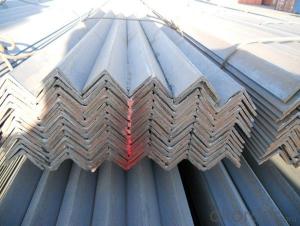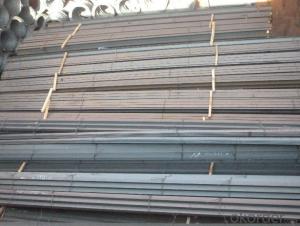Hot Rolled Mild Steel Angle Beams for Structures and for Buildings
- Loading Port:
- Guangzhou
- Payment Terms:
- TT OR LC
- Min Order Qty:
- 25 m.t.
- Supply Capability:
- 200000 m.t./month
OKorder Service Pledge
OKorder Financial Service
You Might Also Like
Product Description:
OKorder is offering Hot Rolled Mild Steel Angle Beams for Structures and for Buildings at great prices with worldwide shipping. Our supplier is a world-class manufacturer of steel, with our products utilized the world over. OKorder annually supplies products to European, North American and Asian markets. We provide quotations within 24 hours of receiving an inquiry and guarantee competitive prices.
Product Applications:
Hot Rolled Mild Steel Angle Beams for Structures and for Buildings are ideal for structural applications and are widely used in the construction of buildings and bridges, and the manufacturing, petrochemical, and transportation industries.
1. Supporting members, most commonly in the house raising industry to strengthen timber bears under houses. Transmission line towers, etc
2. Prefabricated structure
3. Medium scale bridges
4. It is widely used in various building structures and engineering structures such as roof beams, bridges, transmission towers, hoisting machinery and transport machinery, ships, industrial furnaces, reaction tower, container frame and warehouse etc.
Product Advantages:
Hot Rolled Mild Steel Angle Beams for Structures and for Buildings are durable, strong, and resist corrosion.
Main Product Features:
· Premium quality
· Prompt delivery & seaworthy packing (30 days after receiving deposit)
· Corrosion resistance
· Can be recycled and reused
· Mill test certification
· Professional Service
· Competitive pricing
Product Specifications:
.Standards:GB,ASTM,BS,AISI,DIN,JIS
2.Invoicing on theoretical weight or actual weight as customer request
3.Material: JIS G3192,SS400;SS540.
4.Sizes:
EQUAL ANGLES SIZES | |||
a(mm) | a1(mm) | thickness(mm) | length |
25 | 25 | 2.5---3.0 | 6M/12M |
30 | 30 | 2.5---4.0 | 6M/12M |
38 | 38 | 2.5 | 6M/12M |
38 | 38 | 3.0---5.0 | 6M/12M |
40 | 40 | 3.0---6.0 | 6M/12M |
50 | 50 | 3 | 6M/12M |
50 | 50 | 3.7---6.0 | 6M/9M/12M |
60 | 60 | 5.0---6.0 | 6M/9M/12M |
63 | 63 | 6.0---8.0 | 6M/9M/12M |
65 | 65 | 5.0---8.0 | 6M/9M/12M |
70 | 70 | 6.0---7.0 | 6M/9M/12M |
75 | 75 | 5.0---10.0 | 6M/9M/12M |
80 | 80 | 6.0---10.0 | 6M/9M/12M |
90 | 90 | 6.0---10.0 | 6M/9M/12M |
100 | 100 | 6.0---12.0 | 6M/9M/12M |
120 | 120 | 8.0-12.0 | 6M/9M/12M |
125 | 125 | 8.0---12.0 | 6M/9M/12M |
130 | 130 | 9.0-12.0 | 6M/9M/12M |
140 | 140 | 10.0-16.0 | 6M/9M/12M |
150 | 150 | 10---15 | 6M/9M/12M |
160 | 160 | 10---16 | 6M/9M/12M |
180 | 180 | 12---18 | 6M/9M/12M |
200 | 200 | 14---20 | 6M/9M/12M |
5. Material Specifications:
Grade | Yield Strength,N/mm² | Extension Strength N/mm² | |||
Thickness of Steel,mm | |||||
≦16 | >16-≦40 | >40-≦100 | >100 | ||
SS330 | ≧205 | ≧195 | ≧175 | ≧165 | 330-430 |
SS400 | ≧245 | ≧235 | ≧215 | ≧205 | 400-510 |
SS490 | ≧285 | ≧275 | ≧255 | ≧245 | 490-610 |
SS540 | ≧400 | ≧390 | - | - | ≧540 |
FAQ:
Q1: Why buy Hot Rolled Mild Steel Angle Beams for Structures and for Buildings from OKorder.com?
A1: All Hot Rolled Mild Steel Angle Beams for Structures and for Buildings offered byOKorder.com are carefully selected from China's most reliable manufacturing enterprises. Through its ISO certifications, OKorder.com adheres to the highest standards and a commitment to supply chain safety and customer satisfaction.
Q2: How do we guarantee the quality of our products?
A2: We have established an advanced quality management system which conducts strict quality tests at every step, from raw materials to the final product. At the same time, we provide extensive follow-up service assurances as required.
Q3: What is the normal tolerance of Hot Rolled Mild Steel Angle Beams for Structures and for Buildings?
A3: Normally 3%-5%, but we can also produce the goods according to the customers' requests.

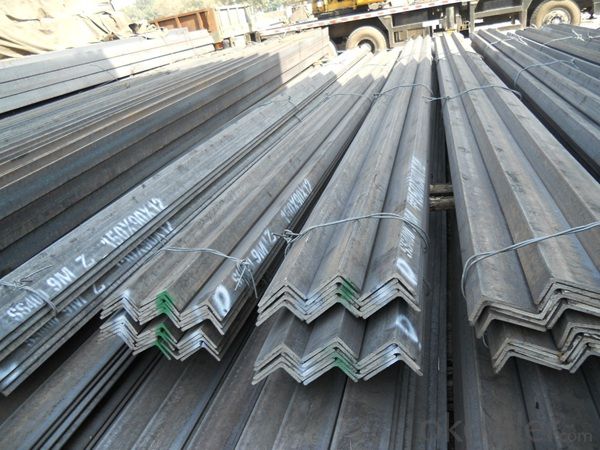
- Q: What is the typical shear strength of steel angles?
- The typical shear strength of steel angles can vary depending on the specific grade and dimensions of the angle. However, a general range for the shear strength of steel angles is typically between 50,000 to 75,000 pounds per square inch (psi).
- Q: How do you prevent corrosion between steel angles and other materials?
- To prevent corrosion between steel angles and other materials, there are several effective measures that can be taken: 1. Protective Coatings: Applying a protective coating such as paint, epoxy, or galvanization on the steel angles can create a barrier between the steel and the surrounding materials, preventing direct contact and reducing the risk of corrosion. 2. Insulation: Using insulating materials like rubber or plastic pads or sleeves between the steel angles and other materials can prevent direct contact and minimize the chances of corrosion. 3. Cathodic Protection: By installing sacrificial anodes or using impressed current systems, a cathodic protection mechanism can be established to protect the steel angles. This process involves creating an electrical current that counteracts the corrosion process, keeping the steel angles intact. 4. Regular Maintenance: Regular inspection and maintenance of the steel angles are crucial to identify any signs of corrosion and take appropriate actions promptly. This can include cleaning the surfaces, repairing any damaged coatings, and replacing corroded parts. 5. Proper Drainage: Ensuring proper drainage around the steel angles is essential to prevent moisture accumulation, which can accelerate corrosion. Proper design and installation of drainage systems can prevent water or other corrosive substances from pooling around the steel angles. 6. Avoiding Chemical Exposure: If the steel angles are in an environment where they may come into contact with chemicals or corrosive substances, it is important to choose materials that are resistant to corrosion. This could involve using stainless steel or other corrosion-resistant alloys that can withstand exposure to the specific chemicals present. Overall, implementing a combination of protective coatings, insulation, cathodic protection, regular maintenance, proper drainage, and material selection based on the environment can effectively prevent corrosion between steel angles and other materials, ensuring their longevity and structural integrity.
- Q: How do steel angles perform in terms of vibration resistance?
- Steel angles generally have good vibration resistance due to their strong and rigid structure. The shape of a steel angle, with its L-shaped cross-section, provides additional strength and stability, making it highly resistant to vibrations. When used in construction or engineering applications, steel angles can effectively absorb and dampen vibrations, minimizing the risk of structural damage or failure. The stiffness and high tensile strength of steel angles allow them to withstand dynamic loads and vibrations caused by various factors such as wind, earthquakes, or machinery operations. They can effectively distribute and dissipate vibrational forces throughout their structure, preventing excessive movement or oscillation. This is particularly important in applications where stability and durability are crucial, such as in the construction of bridges, buildings, or industrial equipment. Additionally, steel angles can be designed and manufactured to meet specific vibration resistance requirements. By selecting appropriate steel grades and dimensions, engineers can optimize the performance of steel angles in terms of vibration resistance. They can also incorporate additional features like stiffeners or reinforcements to further enhance the vibration resistance of steel angle structures. Overall, steel angles have proven to be reliable and efficient in withstanding vibrations, making them a popular choice in various industries and applications where structural integrity is of utmost importance.
- Q: Are steel angles resistant to pests and termites?
- Yes, steel angles are highly resistant to pests and termites. Unlike wood, which is susceptible to damage from termites and other pests, steel is an inorganic material that does not provide a food source for them. This makes steel angles a great choice for construction projects in areas prone to pest infestations. Additionally, steel is not susceptible to rot or decay, further enhancing its resistance to pests. Therefore, using steel angles in construction can help protect buildings from potential damage caused by pests and termites.
- Q: What are the different methods of surface finishing for steel angles?
- There are several different methods of surface finishing for steel angles, each with its own advantages and considerations. The most common methods include painting, galvanizing, powder coating, and shot blasting. Painting is a popular method for surface finishing steel angles as it provides a protective barrier against corrosion and adds an aesthetic appeal. The angle is typically cleaned and primed before applying multiple coats of paint. This method allows for a wide range of color options and can be easily touched up if damaged. Galvanizing involves coating the steel angle with a layer of zinc to protect it from corrosion. This method is particularly effective in harsh environments where the angle may be exposed to moisture or chemicals. Hot-dip galvanizing is the most common method, where the angle is immersed in a bath of molten zinc. This creates a durable and long-lasting finish that requires minimal maintenance. Powder coating is another popular surface finishing method that involves applying a dry powder to the angle and then curing it with heat to form a protective layer. This method offers excellent durability and resistance to corrosion, chemicals, and UV rays. It also provides a smooth and consistent finish, with a wide range of colors available. Shot blasting is a mechanical method of surface finishing that involves blasting the steel angle with high-speed abrasive particles. This removes any rust, mill scale, or other contaminants from the surface, resulting in a clean and smooth finish. Shot blasting also creates a rough texture that improves paint adhesion, making it an ideal pre-treatment before painting or powder coating. It is important to consider the specific requirements of the steel angle's application when choosing a surface finishing method. Factors such as the environment, expected lifespan, aesthetic preferences, and budget should all be taken into account. Consulting with a professional or the steel manufacturer can help determine the most suitable method of surface finishing for steel angles in a particular situation.
- Q: Can steel angles be used in agricultural buildings?
- Yes, steel angles can be used in agricultural buildings. Steel angles, also known as angle iron, are commonly used in construction due to their strength and versatility. In agricultural buildings, steel angles can be utilized for various purposes such as framing, bracing, and supporting the structure. They can be used to create sturdy frames for walls, roof trusses, and other structural elements. Steel angles also provide excellent load-bearing capacity, making them suitable for supporting heavy equipment or machinery commonly found in agricultural buildings. Moreover, steel angles are resistant to corrosion, which is essential in agricultural environments where exposure to moisture and various chemicals is common. Overall, steel angles are a practical and reliable choice for agricultural buildings due to their strength, durability, and resistance to environmental factors.
- Q: What is the lifespan of a steel angle?
- The lifespan of a steel angle can vary depending on various factors such as the quality of the steel, the environment it is exposed to, and the level of maintenance it receives. However, in general, steel angles are known for their durability and long lifespan. With proper care and regular maintenance, a steel angle can last for several decades or even beyond. The corrosion resistance of the steel, protective coatings, and measures taken to prevent rust and deterioration can significantly extend its lifespan. Furthermore, factors such as load-bearing capacity, structural integrity, and overall design play a crucial role in determining the lifespan of a steel angle. Therefore, it is essential to consider the specific application and consult with professionals to ensure optimal performance and longevity.
- Q: What are the different types of steel angles used in machinery?
- There are several types of steel angles commonly used in machinery, including equal angles, unequal angles, L-shaped angles, and T-shaped angles. These angles are used to provide structural support, reinforce joints, and facilitate the assembly of various components in machinery.
- Q: What are the different methods of reinforcing steel angles?
- Reinforcing steel angles can be strengthened in various ways, each with its own benefits and uses. One popular technique involves adding extra steel plates or brackets, which are typically welded or bolted onto the existing angle. This provides added support and strength, making it ideal for situations where the angle is subjected to heavy loads or stress. Another method involves using stiffeners, which are smaller steel angles or plates that are welded perpendicular to the existing angle. These stiffeners help to evenly distribute the load, preventing the angle from buckling or bending under pressure. This method is commonly employed when the angle serves as a structural member, such as in building frames or bridge supports. Furthermore, reinforcing steel angles can be achieved by encasing them in concrete or combining them with composite materials. In this approach, the steel angle is embedded within a concrete matrix or mixed with materials like fiberglass or carbon fiber. This combination enhances strength, durability, and resistance to corrosion. It is often employed in construction projects where the angle is exposed to harsh environments or requires superior performance. In summary, the various methods available for reinforcing steel angles offer choices for increasing their strength, stability, and longevity. The selection of a particular method depends on factors like the specific application, load requirements, and environmental conditions.
- Q: Can galvanized square tubes and angle iron be welded together?
- If you do not clean out the galvanized layer or is not completely clear, it will cause the zinc layer and instantaneous combustion will produce a large number of yellow white floc toxic gases, the most serious is will have a direct effect on the magnetic blow angle due to interruption of welding.
Send your message to us
Hot Rolled Mild Steel Angle Beams for Structures and for Buildings
- Loading Port:
- Guangzhou
- Payment Terms:
- TT OR LC
- Min Order Qty:
- 25 m.t.
- Supply Capability:
- 200000 m.t./month
OKorder Service Pledge
OKorder Financial Service
Similar products
Hot products
Hot Searches
Related keywords



